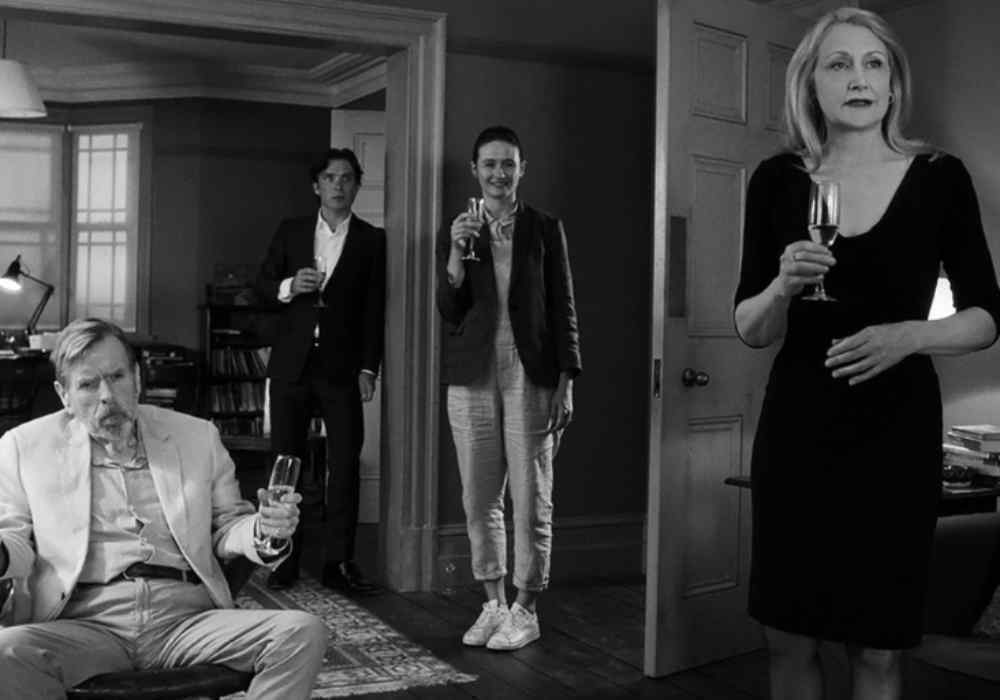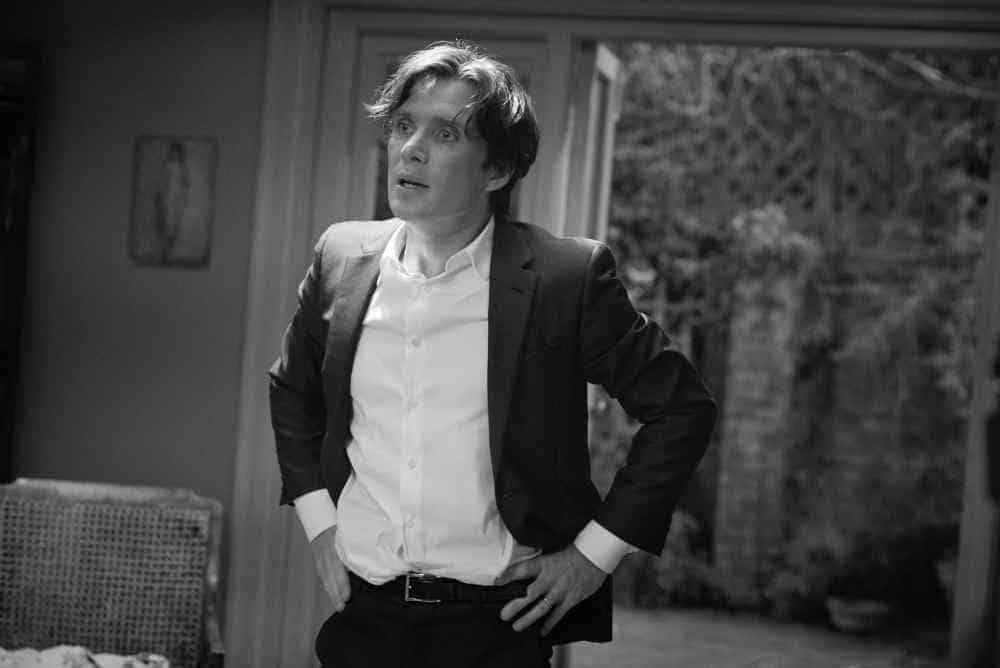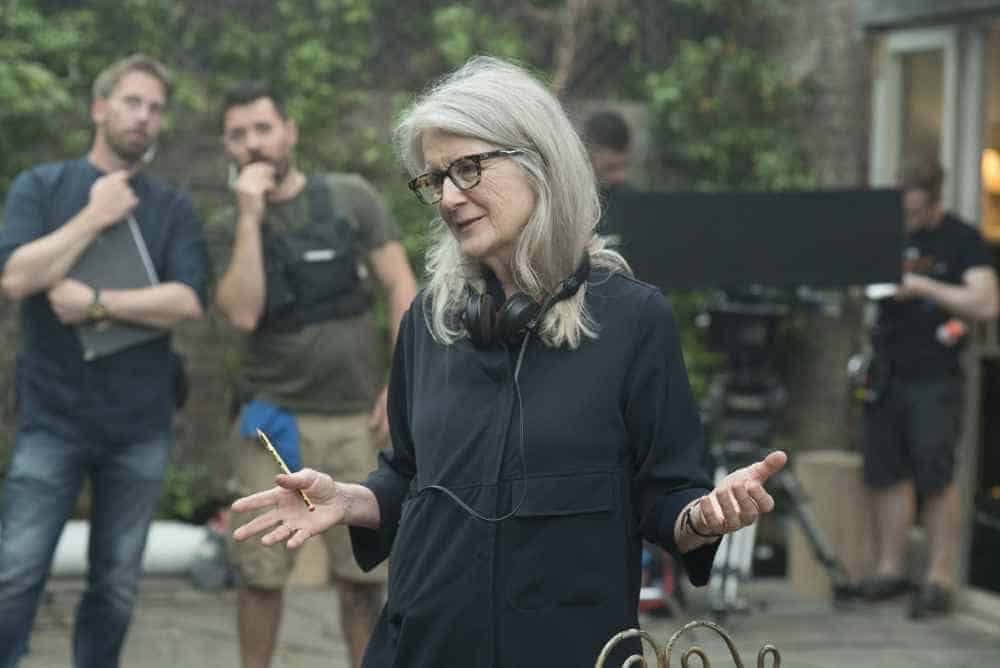Sally Potter discusses getting us into the characters’ heads, the importance of set design for dramatic tension, and getting emotionally charged yet very funny performances from her actors. Read our review of the film here.

The premise of Sally Potter’s darkly witty The Party sounds like a play: seven characters assemble for a house party, where secrets are revealed, and allegiances tested, in real time. But it’s an entirely cinematic experience, if somewhat theatrically inspired. Janet (Kristin Scott Thomas) hosts a party to celebrate her ascent to Shadow Health Minister, but every guest seems intent on stealing her thunder, including her husband, Bill (Timothy Spall). Janet’s friend April (Patricia Clarkson) sardonically comments on everyone else’s hypocrisy, though her soon-to-be-ex boyfriend (Bruno Ganz) ends up acting as a bad influence on everyone. Meanwhile, Bill’s colleague Martha (Cherry Jones) and her pregnant wife Jinny (Emily Mortimer) serve as a foil to the childless Bill and Janet. And Tom (Cillian Murphy), high on cocaine, is there to stir up trouble.
The group has gathered to celebrate Janet’s tireless work to create political change, yet everyone at the party is terrified of any changes in their personal lives. Throughout the film’s quick 71-minute runtime, nobody, even the most idealistic of the group, is immune to personal hypocrisies.
Everything about the film is perfectly judged, from the nuanced physical performances, to the costumes that reveal character and socio-economic situation, to the set which was designed to allow for free movement from one room to the next to ratchet up tension throughout.
I talked to writer-director Sally Potter about how she thought about getting us into the characters’ heads, the importance of set design for dramatic tension, and how she works with actors to get such emotionally charged yet very funny performances.
Seventh Row (7R): The Party is an ensemble film, but we spend a lot of time with characters on their own or in smaller groups. How did you think about showing each character’s limited, subjective perspective?
Sally Potter: We follow seven stories, pretty much equally, over what ended up being 71 minutes. One way to do that is to vary [between scenes] when they’re all together in the room and when they disperse into these small groups or by themselves. I wanted to find a way of keeping track of each of them, so we had a feeling of what was going on — not necessarily the things that each person was saying, but perhaps more importantly, what they weren’t saying. We begin to get a feeling of the secret lives of all these individuals, and then, one by one, the secrets are revealed.
[clickToTweet tweet=”‘Potter shot multiple takes of each scene, once in long-shot and others following individual characters.'” quote=”‘Potter shot multiple takes of each scene, once in long-shot and others following individual characters.'”]
7R: How did you decide between using close-ups, to really get inside one character’s head, versus having multiple characters on screen where you can see their interaction?
Sally Potter: Sometimes, we did both. There would be a few takes of the scene: the camera would hold back for one, and in another, I would ask [cinematographer] Aleksei [Rodionov] to stick with that one character and just follow them, and frame them, and follow their physicality wherever it went.
In the cutting room, the choice is: how do we need to look at the scene? Do we need to be right in there, forensically, with one person, for one moment? Or do we need to look at the whole mise en scène and figure out where people are in the room and what they’re doing? It was quite a jigsaw, actually.
7R: Can you tell me about the editing? There’s so much going on that has to be tracked.
Sally Potter: I went through a lot of drafts, and it gradually got shorter and tighter. That was the challenge: how to make sure that we, the audience, know where everybody is without millions and millions of cutaways. It was just, bit by bit, feeling, “we need to know where Cillian is now” or “we need to know what’s happening with Janet here”. It was put together in the usual way, but with lots and lots and lots of re-cuts — and several test screenings — before the final thing emerged.
[clickToTweet tweet=”‘That was the challenge: how to make sure that we, the audience, know where everybody is without millions and millions of cutaways.'” quote=”‘That was the challenge: how to make sure that we, the audience, know where everybody is without millions and millions of cutaways.'”]
7R: The multiple rooms in the house create a sort of theatre for the characters. The bathroom is the backstage, where people go to have private moments and be truthful to themselves about themselves. The living room is the stage, where everyone convenes, and often performs for each other.
Sally Potter: Each space would have a different function, more or less along the lines of what you so correctly described. I think it’s about social spaces and private spaces, and the living room is the most social space.
One of the things that I noticed, that I think is quite funny, is that women — young girls, especially — often end up having their best conversations in bathrooms. It’s like it’s the only private space that’s left. The truth comes out. For individuals, too, it’s a retreat space or a hiding space. The kitchen is a space where Janet, the politician, is also trying to live out the domestic obligations of her gender.
[clickToTweet tweet=”‘It’s about social spaces and private spaces, and the living room is the most social space.’ ” quote=”‘It’s about social spaces and private spaces, and the living room is the most social space.’ “]
7R: How did you conceive of the sound design for the film? The set sprawls across three different rooms (and the outdoors), and we often hear sound bleeding from one room to the next.
Sally Potter: A lot of it was written into the script. Because the film was all shot on a set, a great deal of the sound, including the very minimalist sound effects, needed to be created afterward to get the feeling of each of these different worlds.
But the single most important thing in the sound design is the choice of music. That was very early on in the script: this notion that you have this vinyl collection of great pieces of music that would take us through a portrait of the inner life of Bill, who is, at the beginning, very silent. The music is speaking for him, in a way. Most of those tracks I’d already chosen before we were shooting and some of them I chose during the editing process.
[clickToTweet tweet=”‘The process of getting into the character has to be through a total form of embodiment. That’s why we work on the clothes a lot, how somebody sits, how they stand, how they move, and so on.'” quote=”‘The process of getting into the character has to be through a total form of embodiment. That’s why we work on the clothes a lot, how somebody sits, how they stand, how they move, and so on.'”]
7R: At the beginning, Bill stays sitting on a chair in the empty living room. Something about that chair reminded me of a throne and the living room like a throne room.
Sally Potter: We spent a lot of time talking about that chair and where it should be. There was a lot of searching for the right chair and where to have the chair. My feeling was: this is a guy who is in love with his sound system so he would have his chair, in an antisocial way, right in the middle of the room, between the two speakers, and he wouldn’t move. Tim and I talked about how he’s anchored in this chair, and he only moves to one other place, which is to go to this sound system. That’s it. That’s his trajectory.
All these other characters are dashing around from one space to another — especially Cillian Murphy’s character — but [Bill is] this anchor in the middle of the space. It’s his retreat, his comfort space — his despair space would be another way of putting it.

7R: In an interview, Cillian Murphy and Timothy Spall talked about how acting in this film was full body acting, unlike so much screen work which is largely in the close-up. How do you approach capturing actors and their bodies on camera?
Sally Potter: It all springs off of the work I do with the actors before the shoot — before they even meet each other, actually — about what the text is, what the scenes are, who the character is, and what the secret life of the character is. It becomes a hidden score for the actor of the secret inner life that runs in parallel with the outer life. That is caught in tiny nuances in the face, but otherwise, it can come out through body language.
The process of getting into the character has to be through a total form of embodiment. That’s why we work on the clothes a lot, how somebody sits, how they stand, how they move, and so on. I give a lot of freedom to the actors to find that way of moving.
Then, it’s about, with the cinematographer, finding a way of looking at that body: where is it most expressive? From the front? From behind, like the back view of Timothy in the chair? Or close-up, like frantically close-up, or far enough away for us to see how the energy of the character is working through the whole body? These are all very, very physical actors. I was quite surprised that, often, they don’t get asked to use their whole body. I think that was very fulfilling for them, and for me, of course.
[clickToTweet tweet=”‘I confined everybody into one environment, it could have become a very static piece. I was trying to squeeze every possible kind of movement through the spaces.'” quote=”‘I confined everybody into one environment, it could have become a very static piece. I was trying to squeeze every possible kind of movement through the spaces.'”]
7R: Murphy and Spall noted that they thought this had a lot to do with your background in dance. Has your work in dance informed how you direct actors?
Sally Potter: When you work with dance or choreography, you’re always aware of how a body moves through space. I was very aware that, in a script like this, where I confined everybody into one environment, it could have become a very static piece. I was trying to squeeze every possible kind of movement through the spaces. Maybe that kind of movement awareness comes from a dance background.
Cillian, for example, is an extremely physical, agile person. He embodied this character with an incredible amount of restlessness, not least because of the drugs that are in his system in the story. When we came to do the scene where there’s the smoke alarm, and I said, “How are we going to get you up to be smashing away at the alarm?” He just kind of leapt up onto the table. He has that facility, in part from working in the theatre.
[clickToTweet tweet=”‘The set was designed so that the camera could move through it, people could appear and disappear like ghosts, and we could capture a lot of variations of movement.'” quote=”‘The set was designed so that the camera could move through it, people could appear and disappear like ghosts, and we could capture a lot of variations of movement.'”]
7R: You have quite a few theatre actors in the film. Does them having that skill set change how you approach directing them?
Sally Potter: One of the advantages of working with people who have worked in the theatre is that they are often very open to a more ensemble approach. They’re not just thinking about themselves and how the camera is going to pick them up. They’re thinking, “What is the energy in this group?” Not just on screen, but also in the working process: we’re a company, we’re an ensemble, and we’re going to feed off of each other and give each other energy.
[clickToTweet tweet=”‘The exact physical movements were never fixed in stone. That was different between each take, even, so that it could have that feeling of freedom and spontaneity.'” quote=”‘The exact physical movements were never fixed in stone. That was different between each take, even, so that it could have that feeling of freedom and spontaneity.'”]
7R: I read that you built a model of the set and used little figures to work out the ways in and out of rooms before shooting. Why was that so important to you?
Sally Potter: The model was for [production designer] Carlos Conti. He built it so that he and I could look at it. Then, we actually mapped it out in three dimensions, in another space, with pieces of tape on the ground, and walked through it and around it. It was partly making calculations of how the camera could move: I didn’t want to build a set which had flying walls or where you lift the ceiling off. I wanted it to have a solid feeling. It had fixed walls, so nothing moved on the set.
But [the set was designed so that] the camera could move through it, people could appear and disappear like ghosts, and [we could capture] a lot of variations of movement. It was useful to plan out how that could work — to be able to squeeze every last bit of juice out of this confined environment. In the moment, one found other ways of shooting and moving. It was not choreographed in advance, other than [that the script] said in which spaces people were doing what they were doing and at what point they moved to another space.

7R: How did your ideas of the set and the blocking evolve from when you wrote the script, to when you used the model, to when you came to shoot the actors?
Sally Potter: Carlos Conti, who I’ve now worked with on a lot of films, is a fantastic collaborator. He’s very camera-aware, not just design-aware and character-aware. He thinks of the set as another character. The first stage in the evolution is the script, because that’s imagining the whole thing. Then, he brings it to life in terms of the setting.
Then, with the actors, I can take it to the next stage. They bring instinct and impulse about how to move and where to move. Bit by bit, it all takes shape. I don’t storyboard. I don’t pre-plan too much. I map, very precisely, the psychology of the scene. It’s pretty much delivered word-perfect, as well; there was no improvisation around the text. But the exact physical movements [and] gestures were never fixed in stone. That was different between each take, even, so that it could have that feeling of freedom and spontaneity in the moment of delivery. Even though much of it was pre-planned, it still had that room to breathe at the moment of shooting.
[clickToTweet tweet=”‘He looks like a male model on a bad day, wearing a steely, metallic grey, expensive suit.'” quote=”‘He looks like a male model on a bad day, wearing a steely, metallic grey, expensive suit.'”]
7R: The costumes for this film are not flashy, but incredibly effective at conveying character. How did you work with costume designer Jane Petrie to provide visual cues about characters’ personalities, professions, and social status?
Sally Potter: I try to put a line or two in the script to give the costume designer some inspiration. For example, Cillian Murphy’s character, the first time we see him, it says “he looks like a male model on a bad day, wearing a steely, metallic grey, expensive suit.” So that gives a lot of clues. And then, Janet’s says, “looks like a politician who is trying to tread a middle path.”
Jane Petrie, who did the costumes, was tuned in so precisely to the characters. She would bring a rail of options, and between the actor, her, and myself, we pretty quickly arrived at the right look. She has a wonderful eye for costume — wonderful. It’s so precise.
You may also be interested in our interviews with other directors whose storytelling is so dependent on the confined spaces of their films. Director Kleber Mendonça Filho discussed the effect of the architecture of the flat at the centre of Aquarius on the characters’ relationships. We talked to director Andrew Haigh about his two-hander 45 Years, which favoured long takes and strict blocking, but was just as focused on its characters’ relationship to one another in space. Director Dominic Cooke discussed his two-hander On Chesil Beach and his approach to capturing actors in their space, and in relation to one another, which is similar to Potter’s approach — though Cooke favours much more rehearsal.

